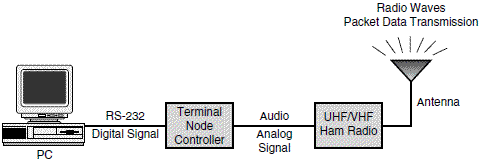Wireless LANs: A Historical Perspective
Network technologies and radio communications were brought together for the first time in 1971 at the University of Hawaii as a research project called ALOHANET. The ALOHANET system enabled computer sites at seven campuses spread out over four islands to communicate with the central computer on Oahu without using the existing unreliable and expensive phone lines. ALOHANET offered bidirectional communications in a star topology between the central computer and each of the remote stations. The remote stations had to communicate with each other via the centralized computer.
In the 1980s, amateur radio hobbyists, hams, kept radio networking alive within the U.S. and Canada by designing and building terminal node controllers (TNCs) to interface their computers through ham radio equipment (see Figure below). A TNC acts much like a telephone modem, converting the computer's digital signal into one that a ham radio can modulate and send over the airwaves by using a packet switching technique. In fact, the American Radio Relay League (ARRL) and the Canadian Radio Relay League (CRRL) have been sponsoring the Computer Networking Conference since the early 1980s to provide a forum for the development of wireless WANs. Thus, hams have been using wireless networking for years, much earlier than the commercial market.

In 1985, the Federal Communications Commission (FCC) made the commercial development of radio-based LAN components possible by authorizing the public use of the Industrial, Scientific, and Medical (ISM) bands. These frequencies reside between 902MHz and 5.85GHz, just above the cellular phone operating frequencies. The ISM band is very attractive to wireless network vendors because it provides a part of the spectrum upon which to base their products, and end users do not have to obtain FCC licenses to operate the products. The ISM band allocation has had a dramatic effect on the wireless industry, prompting the development of wireless LAN components. Without a standard, though, vendors began developing proprietary radios and access points.
In the late 1980s the Institute for Electrical and Electronic Engineers (IEEE) 802 Working Group, responsible for the development of LAN standards such as ethernet and token ring, began development of standards for wireless LANs. Under the chairmanship of Vic Hayes from NCR, the IEEE 802.11 Working Group developed the Wireless LAN Medium Access Control and Physical Layer specifications. Before the ratification of the standard, companies began shipping proprietary wireless LAN radio cards and access points operating in the 902MHz ISM band. These products were initially relatively expensive, at US$1,400 per radio card. As a result, wireless LANs at that time were feasible only for satisfying network requirements when mobility provided tremendous gains in efficiency and resulting cost savings.
The IEEE Standards Board approved the standard on June 26, 1997, and the IEEE published the standard on November 18, 1997. The finalization of this standard prompted vendors to release 1Mbps and 2Mbps 802.11-compliant radio cards and access points throughout 1998. In December 1999, the IEEE released supplements (802.11a and 802.11b) to the 802.11 standard in order to increase performance of wireless LANs up to 54Mbps. Vendors began shipping wireless LANs operating at 11Mbps throughout 2000 (at prices of less than $200 per radio card) and at 22Mbps starting in 2001. The 54Mbps wireless LANs (IEEE 802.11a-compliant) will be available toward the end of 2001, slightly ahead of HiperLAN/2 systems (802.11's competitor).
Because of falling prices and increasing performance, wireless LANs today are taking on a much larger role in horizontal enterprise applications. The price and performance of wireless LANs are getting much closer to traditional wired, ethernet networks. Prices for wireless LAN radio cards are expected to decrease by at least 50% during 2001. It's very likely that the average price for wireless LAN radio cards will match the price of equivalent (performance and form factor) ethernet cards as we enter 2002. As a result, an information system manager is now in a position to give serious consideration to IEEE 802.11 wireless LANs for supporting high-speed network connections to PC and laptop users within his facilities.
In this tutorial:
- Wireless Networks
- Mobility
- Installation in Difficult-to-Wire Areas
- Increased Reliability
- Reduced Installation Time
- Wireless LAN Applications
- Home and Small Office
- General Enterprise Systems
- Wireless Services
- Wireless LAN Technologies
- IEEE 802.11
- HiperLAN
- HomeRF SWAP
- Bluetooth
- Wireless LAN Implications
- Multipath Propagation
- Path Loss
- Radio Signal Interference
- Inward Interference
- Outward Interference
- Techniques for Reducing Interference
- Potential Frequency Interference Between 802.11 and Bluetooth
- Limited Battery Longevity
- System Interoperability
- Network Security
- Security Threats
- Security Safeguards
- Application Connectivity Problems
- Installation Issues
- Health Risks
- Wireless LANs: A Historical Perspective
